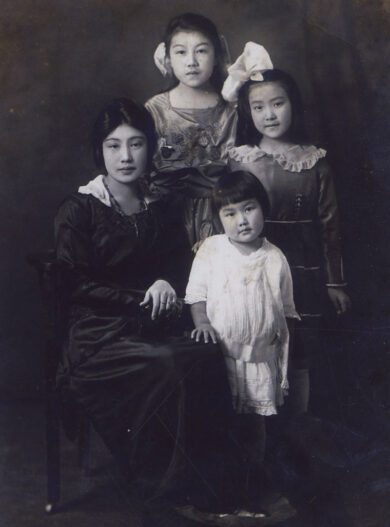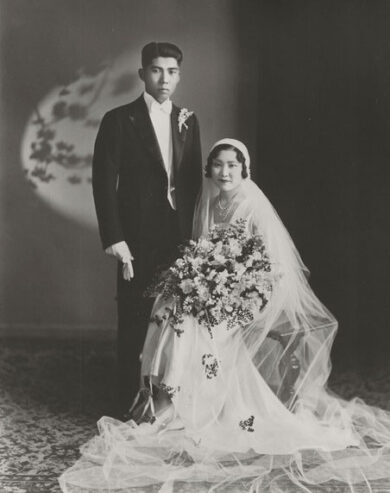Exhibit: Santa Barbara Asian American & Pacific Islander Heritage, 1870s-1970s
John Mitsuo Nakagawa (1910-2011) and Alice Hayashida Nakagawa (1910-2008)
Carpenter, Family-Oriented, Resilient
By Gloria Peyrat and Holly Snyder

Takeko and her three oldest daughters, c.1920. Courtesy of the Nakagawa family.
Early Life
John Mitsuo Nakagawa was born on November 20, 1910 in Los Angeles to parents Torakichi and Koto (Kamikawa) Nakagawa. He had one sister, Faith Hinako Yamada, who also later lived in Santa Barbara. Nakagawa’s parents moved back to Japan in 1931. They didn’t sign a re-entry document to come back to the US because they planned to retire in Japan. However, after her husband passed away and she lost her property in the bombing raids on Osaka, Koto wanted to return to her family in the States. In 1955, Koto was able to return to the United States with the help of Chet Holcomb, a well-known Santa Barbara NewsPress reporter, and Congressman, Representative Teague of Ventura, who helped pass a bill signed by President Eisenhower allowing Koto to join her family here. She lived with her son and his family in Santa Barbara until she passed away at age 88 in 1961.
Alice Kaoru Hayashida was born on May 3, 1910 in Los Angeles to parents Tohei and Takeko Hayashida. Alice and her sisters Kayoko and Mieko grew up in Los Angeles in the Japanese section near city hall. Their father was a grocer and died of the flu during WWI. Takeko was working in a restaurant owned by Matakichi Inouye and they married and had four more children together. Alice described her stepfather as a very kind man and a gourmet (he loved food and ate well). With the success of his restaurant Alice was able to take piano and dance lessons when she was young. Matakichi also was able to sponsor sumo wrestlers. The family also owned a car and often vacationed in the southwest.

John and Alice Nakagawa’s wedding picture, 1933, Los Angeles. Courtesy of the Nakagawa family.
John Nakagawa and Alice Hayashida knew each other while growing up in the Japanese section of Los Angeles and went to the same school until John left for Japan in the 8th grade, However, he returned to LA and took trips back to Japan a number of times. Alice also took trips to Japan. They also went to Japanese school to retain the Japanese language and culture.
John and Alice were married on May 7, 1933 in Riverside, California. They had two sons, Morio and Richard, prior to WWII and one daughter, Gloria, born toward the end of the war.
World War II
The Nakagawas suffered the internment of the Japanese Americans for four years, first in Manzanar, then in Tule Lake. They were living and working in Los Angeles at the time they were forced into the camps. Morio was five-years old and Richard was one. Gloria was born in Tule Lake in 1944. Morio remembers the camp’s school where he learned math so well that when he started school in Santa Barbara at age nine, he skipped a grade and graduated from high school at age 17.
In 1943, they filled out a questionnaire that included two key questions. Those who checked “no” and “no” to the two questions were sent to Tule Lake and were considered the “troublemakers” and of questionable loyalty. The questions were “27. Are you willing to serve in the armed forces of the United States on combat duty, wherever ordered? 28. Will you swear unqualified allegiance to the United States of America and faithfully defend the United States from any or all attack by foreign or domestic forces, and forswear any form of allegiance or obedience to the Japanese emperor, or any other foreign government, power, or organization?” John refused to agree. Japanese Americans who went to Tule Lake were often socially shunned by those Japanese who were not rebellious and felt the best thing to do was to be quiet and submissive. This division carried over after the war when people were back to normal life.

John, Alice, oldest son Morio, middle son Richard, 1942. Courtesy of the Nakagawa family.
Santa Barbara

Mrs. Koto Nakagawa and family after she regained re-entry into the US, 1955. Photo from Los Angeles Times article. Courtesy of the Nakagawa Family.
The Nakagawas moved to Santa Barbara on February 22, 1946, upon their release from the Internment Camp. John started work for the railroad and lived on Modoc Road. After four or five years, he quit the railroad and made his living mainly as a carpenter, but he was a gardener and painter as well.
John was the head carpenter at the Santa Barbara Biltmore Hotel during his last working years from 1973 to 1985. Alice held a few part time jobs but primarily spent her days as a housewife—she spent a lot of time cooking, sewing their children’s clothes, knitting and crocheting. She worked part time knitting dresses for a Montecito clothes shop. She also worked in a small factory putting together little ships in bottles. She also did some house cleaning. These were short-term jobs.

Gloria Nakagawa, Hope School kindergarten photo, 1950. Courtesy of the Nakagawa family.
Acknowledgements
Gloria Nakagawa Peyrat
Ancestry.com
FamilySearch.org
John Mitsuo Nakagawa, Obituary 18F-305, Santa Barbara County Genealogical Society (https://sbgen.org/start-your-search/search-database/#/search/); citing Obituary Scrapbooks, held by the Santa Barbara Historical Museum, Gledhill Library.
Alice Kaoru Nakagawa, Obituary 18F-286, Santa Barbara County Genealogical Society (https://sbgen.org/start-your-search/search-database/#/search/); citing Obituary Scrapbooks, held by the Santa Barbara Historical Museum, Gledhill Library.
Newspapers.com
